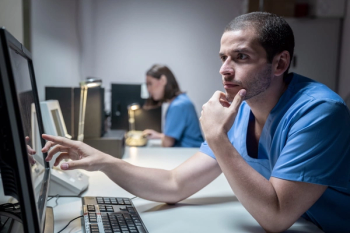
Skeletal Muscle Loss and Dementia: What Emerging MRI Research Reveals
In a recent interview at the RSNA conference, Shadpour Demehri, MD and Kamyar Moradi, MD discussed new brain MRI research findings that demonstrated a link between increased dementia risk and sarcopenia with the temporalis muscle.
Skeletal muscle loss may play a significant role in assessing dementia risk, according to new brain MRI research presented at the Radiological Society of North America (RSNA) conference.
Utilizing the temporalis muscle as a surrogate marker for generalized sarcopenia, the study authors reviewed brain MRI data for 621 non-demented participants (mean age of 77.3) drawn from an Alzheimer’s Disease Neuroimaging Initiative cohort. Employing a 1076.4 mm cutoff to differentiate large and small cross-sectional area (CSA) of the temporalis muscle, the researchers noted that 488 participants had a small CSA and 131 participants had a large CSA.
“We found that the presence of sarcopenia is associated with a 61 percent increased risk of dementia over an (approximate) median of six years,” noted lead study author Kamyar Moradi, M.D., a postdoctoral research fellow in the Department of Radiology and Radiological Sciences at the Johns Hopkins University School of Medicine.
In a r
“My immediate motivation was to try to use that hidden data within all the conventional MRIs that we have as a surrogate marker for sarcopenia, generalized sarcopenia, and try to see whether those measures could help better predict outcomes,” explained Dr. Demehri, a professor of radiology within the Department of Radiology and Radiological Sciences at the Johns Hopkins University School of Medicine.
In addition to a higher risk of dementia, the researchers found that a smaller temporalis muscle CSA was also associated with greater decreases in structural brain volume and the memory composite score.
(Editor's note: For additional coverage from the RSNA conference, click
In light of these findings, the study authors emphasized the opportunistic screening potential with brain MRIs that could lead to preventive measures for patients to build muscle and possibly reduce dementia risk.
“Muscle loss or changes in muscle composition is something that is fundamentally reversible,” noted Dr. Demehri. “ … If you can find some sort of like reversible relationship that explains this ‘muscle brain cross talk,’ and we can reverse some of that on the muscle side of this equation, that could (have a tremendous impact).”
For more insights from Drs. Demehri and Moradi, watch the video below.
Reference
1. Moradi K, Lu H, Zhu Y, et al. Skeletal muscle loss is associated with increased risk of dementia-related outcomes: longitudinal observational study using ADNI brain MRIs. Poster presented at the Radiological Society of North America (RSNA) 2024 110th Scientific Assembly and Annual Meeting Dec. 1-5, 2024. Available at:
Newsletter
Stay at the forefront of radiology with the Diagnostic Imaging newsletter, delivering the latest news, clinical insights, and imaging advancements for today’s radiologists.




























